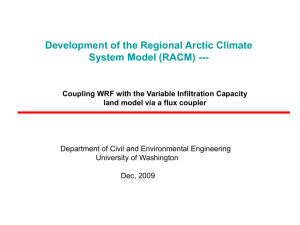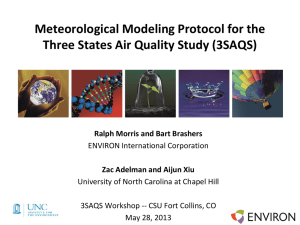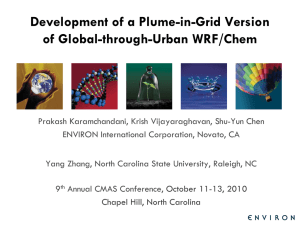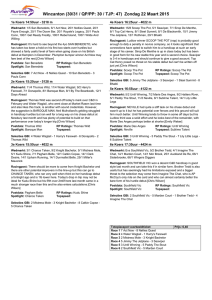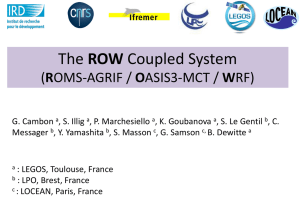WRF-VIC - BioEarth
advertisement
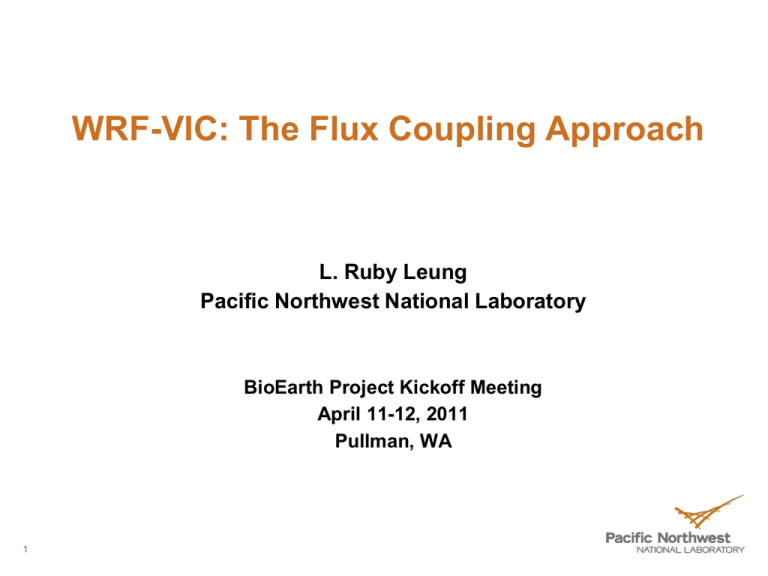
WRF-VIC: The Flux Coupling Approach L. Ruby Leung Pacific Northwest National Laboratory BioEarth Project Kickoff Meeting April 11-12, 2011 Pullman, WA 1 What is WRF WRF is a “community model” that stands for Weather Research and Forecasting model – a free and shared resource with distributed development (NCAR, NOAA, AFWA, FAA, NRL, …) and centralized support (NCAR) Since version 2.1 (2005), WRF has two dynamical cores: ARW and NMM – both non-hydrostatic, Eulerian mass, with terrain following vertical coordinates Under the NCAR NRCM initiative (2003 – 2008), new features have been added to WRF for regional climate applications WRF includes many options for physics parameterizations, including several land surface models WRF-Chem includes ‘online’ chemistry to simulate trace gases and particulates simultaneously with the meteorological fields PNNL scientists have been major contributors to WRF and WRFChem, including recent implementations of all CAM4 and CAM5 physics for consistency with CCSM 2 What is VIC VIC is a macroscale hydrologic model that includes features important for atmosphere-land-vegetation coupling Parameterize subgrid variability of precipitation Infiltration excess runoff Surface- and groundwater interactions Saturation excess runoff ARNO baseflow curve 3 Hydraulic redistribution Interactions of water movement between the root system and soil porous media Coupling of VIC with Atmospheric Models To enable VIC to be coupled to atmospheric models, VIC was modified from ‘time-before-space’ to ‘space-before-time’ coding structure (Liang et al. 2006) MM5 and VIC exchange fluxes through a subroutine call from MM5 (Fortran) to VIC (C) Map VIC land surface properties using those defined by the MM5 preprocessor for Noah LSM MM5-VIC surface properties and initialization follow the standard VIC procedures and applied to the North American monsoon region (Zhu et al. 2009) Added a groundwater parameterization (Liang et al. 2003) to simulate surface water – groundwater interactions MM5-VIC applied to the U.S. at 60 km grid resolution for 1986 – 2002 (Leung et al. 2010) 4 Terrestrial water storage anomaly Leung et al. (2010) 5 The Flux Coupling Approach Regional Arctic Coupled Model (RACM) and PNNL iRESM WRF (v3.2) and VIC (v.4.0.4) have been added to the CESM repository and communicate with the flux coupler CPL7 VIC surface and subsurface runoff parameterizations added to CLM4 The flux coupling approach allows each model to be applied on its own grids and be maintained as separate models and utilized different CPUs GCM/Reanalysis Ocean (ROMS) Atmosphere (WRF/Chem) Land/Veg/C/N (CLM/VIC) Flux Coupler (CPL7) Ocean (POP) 6 Atmosphere (CAM) RESM Sea Ice (CSIM) CESM Running WRF-VIC Configure WRF-VIC domain (only tested the same domain for WRF/VIC with no nesting) using WRF WPS Generate a mapping file for mapping of fluxes between WRF and VIC using SCRIP Create input data for WRF from global reanalysis or GCMs using WRF WPS Create data for data ocean (if not coupled with an ocean model) based on SST from WPS Create input data for VIC Soil, vegetation, snowband parameter files based on global 0.05 degree data Run offline VIC with atmospheric forcing interpolated from 1/8 degree data to generate initial conditions for VIC (e.g., 1-hour time step, energy mode) Create VIC initial conditions for WRF-VIC Compile and run WRF-VIC in the CESM environment 7 Testing of WRF-CLM/VIC WRF-CLM has been tested using a global domain with CLM input data available from CCSM WRF-CLM has also been applied in a regional domain for western US at 12 km resolution using high resolution CLM data (0.05 degree) (2003/10 – 2004/9) WRF-VIC has been tested in a global domain and an Arctic domain (Chunmei Zhu, UW) PNNL will test WRF-VIC in a western US or PNW domain Simulated rainfall from WRF-CLM on global domain 8 Simulated skin temperature from WRF-CLM on regional domain Comparison of observed and WRF-CLM simulated fluxes Green Ridge, OR Tonzi, CA 9 Discussion: Model domain Nesting could be a big challenge Region and resolution Computational resources and wall clock time WRF coupling with other components Online/offline coupling with chemistry (WRF-CMAQ)? Offline coupling with emission (MEGAN)? Merging of codes that involve WRF coupled to other components VIC coupling with other components Online coupling with managed and unmanaged ecosystems and biogeochemistry models (CropSyst and RHESSys) Online coupling with river routing (RHESSys)? Offline coupling with water management and policy (ColSim) Merging of codes that involve VIC coupled to other components Consistency across models Hydrologic (VIC vs RHESSys) and biogeochemistry components Code management 10 Common code repository Central input and output data archive

